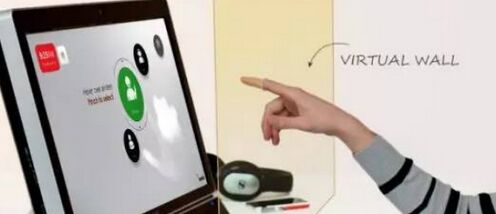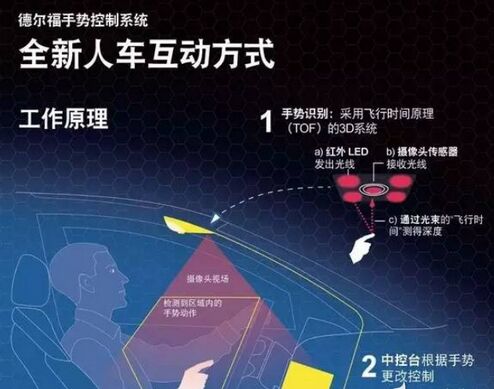Application of multiple gesture control technologies in automotive electronics
Gesture control is used more and more in our daily life, such as gesture control computer, gesture control TV, and more intelligent is to use gestures to control the camera to play games. Gesture control makes our life more and more exciting, and in some ways makes our operation easier and easier.
This article refers to the address: http://

1. Gesture control in the car application
In the car, gesture control is also very useful, and its biggest advantage is that it can simplify the operation, allowing the owner to achieve various operations more quickly. Imagine the operation that you need to use when driving normally. The left-hand turn signal, the right-hand wiper, and the hands hold the steering wheel at the same time. For the manual transmission model, the left foot clutches the right-foot brake and the throttle, and the right hand also manipulates the shift lever. This is not the case for adjusting the windows, mirrors, seats, and the center console that handles a lot of buttons (even in the era of touch screens, virtual buttons still exist).
At the CES show, the Volt Golf R Touch concept car exhibited by Volkswagen was very cool. The hand is placed in the rear of the car and swings automatically. When you get into the car, raise your hand and swipe it beside the head. The sunroof will open automatically. When you touch the center console, the volume will become louder... Perhaps these are exaggerated, but the most basic gesture control can include location navigation, adjusting the temperature inside the car, adjusting the volume of the car music, selecting songs, adjusting the seat position, and changing the speed of the cruise control system.
2. Type of gesture recognition
The core of gesture control is gesture recognition technology. As far as the current technology is concerned, most of the gesture recognition uses computer vision technology. Gesture recognition from simple to complex to roughly fine, can be roughly divided into three levels: two-dimensional hand recognition, two-dimensional gesture recognition, three-dimensional gesture recognition.
The first two gesture recognition technologies are based entirely on the two-dimensional level, while the third gesture recognition technology is based on the three-dimensional level. The most fundamental difference between 3D gesture recognition and 2D gesture recognition is that the input required for 3D gesture recognition is deep information, which makes 3D gesture recognition much more complicated than 2D gesture recognition in both hardware and software. . Of course, 3D recognition can also identify more actions.
The hardware implementation of 3D recognition generally includes three modes: optical time, structured light, and multi-angle imaging. Let's take a look at the principles of these technologies and their applications in cars.
3. Flying time gesture recognition
The basic principle of Time of Flight is to load a light-emitting element, and the photons emitted by the light-emitting element will reflect back when they hit the surface of the object. Using a special CMOS sensor to capture these photons emitted by the illuminating element and reflected back from the surface of the object, the photon flight time can be obtained. According to the photon flight time, the distance of the photon flight can be derived, and the depth information of the object is obtained.
Since the light travels very fast, the ToF-based sensor requires a femtosecond shutter to measure the light flight time. This is one of the reasons why ToF technology is difficult to popularize. Such a sensor chip is too expensive.
Delphi developed its own gesture recognition system based on the principle of optical time, and its structure and operation are as follows:

Of course, there is also a way to change the light pulse to radio waves. The extremely high frequency millimeter wave radio waves can also be used to capture information such as motion, distance, speed, etc., and the sensing error is fine to millimeters. However, how to miniaturize devices with such precision is a very difficult thing. The most difficult part is that miniaturization affects the transmission power and efficiency of the device, and the sensitivity of sensing.
4. Structured light gesture recognition
The basic principle of structured light technology is similar to that of ToF technology, except that it uses light with a pattern of points, lines or faces.
The basic principle of this technology is: first, the laser emitter projects the structured light to the front surface of the human body, and then uses the infrared sensor to receive the structured light pattern reflected by the human body. Then, the processing chip calculates spatial information of the human body of the object according to the position and the degree of deformation of the receiving pattern on the camera. When the object is closer to the laser projector, the displacement caused by the refraction is smaller; when the object is farther away, the displacement caused by the refraction will correspondingly become larger. Combined with the principle of triangulation, and then performing depth calculation, the three-dimensional object can be identified and the entire three-dimensional space can be restored.
5. Multi-angle imaging gesture recognition
Multi-angle imaging technology is the same as stereo imaging technology. The basic principle of this technology is to use two or more cameras to simultaneously capture images, as if humans used both eyes and insects to observe the world with multiple eyes, by comparing these differences. The difference in images obtained by the camera at the same time, using an algorithm to calculate the depth information, thereby multi-angle three-dimensional imaging.
Multi-angle imaging does not require any additional special equipment and relies entirely on computer vision algorithms to match the same target in both images.
6. Three gesture recognition contrasts
Multi-angle imaging is the lowest hardware requirement in 3D gesture recognition technology, but at the same time the software complexity is the highest. Compared with the disadvantages of high cost and high power consumption, the two techniques of structured light or optical flying time can provide three-dimensional gesture recognition effect of “cheap and good qualityâ€.
12V 100Ah Bluetooth Lithium Battery
12V 100Ah Bluetooth Lithium Battery,Lithium Battery Rechargeable,Lithium Battery For Solar,Lifepo4 Battery 100Ah
ShenZhen UFO Power Technology Co., Ltd. , https://www.ufobattery.com